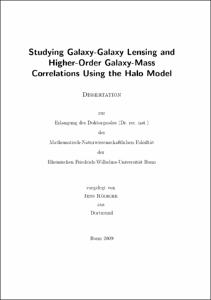Dabringhausen, Jörg: The formation and the stellar populations of dwarf galaxies. - Bonn, 2013. - Dissertation, Rheinische Friedrich-Wilhelms-Universität Bonn.
Online-Ausgabe in bonndoc: https://nbn-resolving.org/urn:nbn:de:hbz:5n-33861
Online-Ausgabe in bonndoc: https://nbn-resolving.org/urn:nbn:de:hbz:5n-33861
@phdthesis{handle:20.500.11811/5778,
urn: https://nbn-resolving.org/urn:nbn:de:hbz:5n-33861,
author = {{Jörg Dabringhausen}},
title = {The formation and the stellar populations of dwarf galaxies},
school = {Rheinische Friedrich-Wilhelms-Universität Bonn},
year = 2013,
month = nov,
note = {Ultra-compact dwarf galaxies (UCDs) are stellar systems with masses similar to those of dwarf elliptical galaxies (dEs), but with characteristic radii that are about a factor of ten smaller than those of dEs. One of the most intriguing properties of UCDs is that the mass-to-light ratios implied by their internal dynamics are rather high, even though it is unlikely that UCDs contain significant amounts of dark matter. This suggests that the reason for the high mass-to-light ratios is a varying stellar initial mass function (IMF) in UCDs, even though the IMF seems remarkably invariant in the Milky Way. This apparently invariant IMF for star forming systems in the Milky Way is known as the canonical IMF. In principle, the mass-to-light ratios of an old stellar population be increased either by additional faint, low-mass stars or by additional remnants of massive stars. In order to decide which one of these two cases applies to the UCDs, the frequency of bright X-ray sources in UCDs was studied. This is because a bright X-ray source in a UCD can be interpreted as a low-mass X-ray binary (LMXB), which is composed of a low-mass star and a stellar remnant. The fraction of the UCDs in the Virgo cluster that contain a bright X-ray source is indeed remarkably high, and the variation of the IMF that explains this frequency of X-ray sources with an overabundance of LMXBs in these UCDs is consistent with their high mass-to-light ratios. This suggests that the UCDs formed with a larger number of massive stars than the canonical IMF would imply. As a consequence, the UCDs would have been extremely dense when star-formation took place in them. These extreme initial conditions may be the reason why the IMF in UCDs would deviate from the canonical IMF in the first place. Regarding the origin of the UCDs, it has been argued before that they are created by the interaction between gas-rich galaxies. However, the formation of dEs may have been triggered by the same process, even though their structural parameters are largely different from those of UCDs. This notion is supported (among other reasons) by the finding that young galaxies that formed through the interaction between gas-rich galaxies would probably evolve into dEs as far as their masses and radii are concerned. This formation scenario for dEs poses however a challenge to the currently prevailing cosmological model.},
url = {https://hdl.handle.net/20.500.11811/5778}
}
urn: https://nbn-resolving.org/urn:nbn:de:hbz:5n-33861,
author = {{Jörg Dabringhausen}},
title = {The formation and the stellar populations of dwarf galaxies},
school = {Rheinische Friedrich-Wilhelms-Universität Bonn},
year = 2013,
month = nov,
note = {Ultra-compact dwarf galaxies (UCDs) are stellar systems with masses similar to those of dwarf elliptical galaxies (dEs), but with characteristic radii that are about a factor of ten smaller than those of dEs. One of the most intriguing properties of UCDs is that the mass-to-light ratios implied by their internal dynamics are rather high, even though it is unlikely that UCDs contain significant amounts of dark matter. This suggests that the reason for the high mass-to-light ratios is a varying stellar initial mass function (IMF) in UCDs, even though the IMF seems remarkably invariant in the Milky Way. This apparently invariant IMF for star forming systems in the Milky Way is known as the canonical IMF. In principle, the mass-to-light ratios of an old stellar population be increased either by additional faint, low-mass stars or by additional remnants of massive stars. In order to decide which one of these two cases applies to the UCDs, the frequency of bright X-ray sources in UCDs was studied. This is because a bright X-ray source in a UCD can be interpreted as a low-mass X-ray binary (LMXB), which is composed of a low-mass star and a stellar remnant. The fraction of the UCDs in the Virgo cluster that contain a bright X-ray source is indeed remarkably high, and the variation of the IMF that explains this frequency of X-ray sources with an overabundance of LMXBs in these UCDs is consistent with their high mass-to-light ratios. This suggests that the UCDs formed with a larger number of massive stars than the canonical IMF would imply. As a consequence, the UCDs would have been extremely dense when star-formation took place in them. These extreme initial conditions may be the reason why the IMF in UCDs would deviate from the canonical IMF in the first place. Regarding the origin of the UCDs, it has been argued before that they are created by the interaction between gas-rich galaxies. However, the formation of dEs may have been triggered by the same process, even though their structural parameters are largely different from those of UCDs. This notion is supported (among other reasons) by the finding that young galaxies that formed through the interaction between gas-rich galaxies would probably evolve into dEs as far as their masses and radii are concerned. This formation scenario for dEs poses however a challenge to the currently prevailing cosmological model.},
url = {https://hdl.handle.net/20.500.11811/5778}
}









